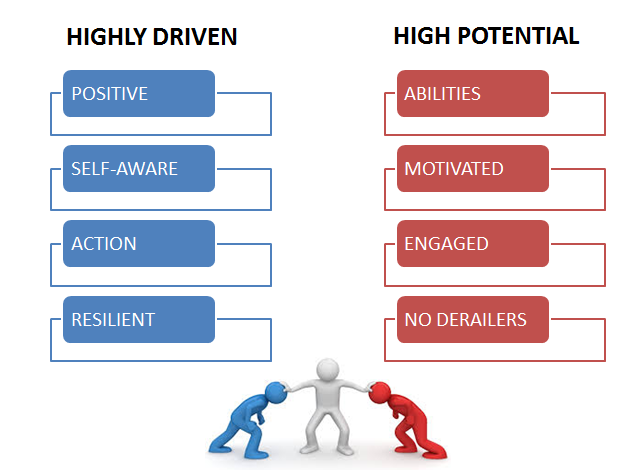
Help Identify the Differences Between High Potential Employees and Highly Driven Employees
A significant amount of our work at Advantexe Learning Solutions is the design, development, and delivery of learning engagements for high potential leaders. Over the past six weeks, I have personally delivered four significant engagements utilizing business simulations to leading organizations in the Pharmaceutical, Chemical, Technology, and Professional Services industries to a variety of audiences.
After most of our deliveries, our direct client who brought us in for the assignment will ask us for feedback on the groups in terms of our observations, insights, and perspectives of participants. They will do this even when they might have dedicated observers watching and tracking the behaviors and actions of participants in simulation workshops for further feedback and analysis.
Last week, immediately following a session, I asked our client how she thought it went and if she needed anything else from me or our Advantexe team. Her answer was as expected: “Oh…just looking for any information I can get from you to make sure that these are really the high potential employees and future leaders of our company.” In response, I provided a high-level person-by-person review of all 24 participants in the program and gave some anecdotal feedback on everyone. Our client then asked me to elaborate a little bit more on one specific participant who we can call Fred Clement (not his real name). I shared that Fred seemed to be highly motivated for success and a real hustler. He was always early to sessions, the first one on the pre-calls, he set up additional feedback sessions for his simulation team, and was always asking questions and looking for ways to optimize performance. Our client responded that my observations were similar to observations received from the observers and his peers. Intrigued, I politely asked her if these observations were “good or bad,” and I was surprised by her answer: “I am not sure yet. We are still calibrating the results and observations. My sense is that Fred might not be a true ‘high potential employee’ and may be more of a highly driven core performer.”
I was intrigued even further. The conversation got me thinking about the current state of high potentials, what is a high potential, where do they fit, and of course how does a business simulator enhance their skills.
Here are a few quick perspectives to share in a short blog that hopefully will have some relevance and impact for our audience of talent professionals and business leaders.
Highly Driven vs. High Potential
The model below illustrates some of our perspectives about the differences between highly driven employees and high potential employees:

Defining Highly Driven Employees
Below are a few brief characteristics of highly driven employees:
Positive Attitude
Highly driven; think they can do anything if they put their mind to it and are always very positive in their personality style and approach to the world.
Self-Aware: Knows Their Own Strengths and Weaknesses
They don’t try to do things they know they can’t do; they focus on what they are good at and try harder than everyone else to be successful.
Action Oriented
They are busy, they are doing things, they are trying new things, and they are constantly taking action. Sometimes, being too action oriented can cause unnecessary mistakes or poor business decisions but they are driven to action and learning from mistakes.
Resilient
Highly motivated people can take rejection and failure and move on quickly; they have “short memories” and can become positive and motivated again quickly after a failure or rejection.
Defining High Potential Employees
Below are a few brief characteristics of high potential employees:
- Abilities - Have a general manager mindset, intellectual ability to deal with complex situations and business challenges, have positive personality types that can lead other people, and have strong emotional intelligence and resilience.
- Motivated - Are driven to excel and achieve results. Want to advance career and take on more leadership roles. Are active in pursuing development and skills to get to the next level.
- Engaged - Love the company, industry, and the work. Are engaged and looking forward to a long and successful career in the organization.
- Lack of Derailers - The high potential leaders of the future don’t have any derailers that could limit potential. Often in high potential leaders, derailers are considered overused strengths, but recently derailers have broadened to include darker personality issues such as extreme skepticism and narcissistic tendencies.
After thinking about these characteristics, the topic is even more interesting and the implications to talent development are more important. At the highest level, it seems – or at the least this is my opinion – that the greatest difference between a highly motivated employee and a high potential employee is that the high potential leader will make fewer business mistakes. Think about the characteristics: the highly motivated employee does whatever is needed, keeps moving forward, learns from mistakes and moves on in a positive way. The high potential employee is very smart, is motivated, in it for the long-term, and somewhat risk adverse.
Now the big questions to ponder…
Do they need different development paths? Is it ok to keep them separate or can they learn from each other? Do business simulations help identify differences? Sometimes these blogs give answers, and sometimes they give questions. Today, it’s the latter. Comments, questions, ideas to share.




